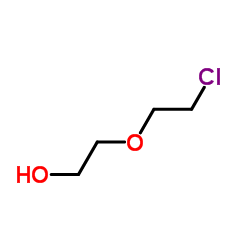Hydroxyzine dihydrochloride

Hydroxyzine dihydrochloride structure
|
Common Name | Hydroxyzine dihydrochloride | ||
|---|---|---|---|---|
| CAS Number | 2192-20-3 | Molecular Weight | 447.826 | |
| Density | 1.182 g/cm3 | Boiling Point | 499.2ºC at 760 mmHg | |
| Molecular Formula | C21H29Cl3N2O2 | Melting Point | 190-192°C | |
| MSDS | Chinese USA | Flash Point | 255.7ºC | |
| Symbol |

GHS07 |
Signal Word | Warning | |
Use of Hydroxyzine dihydrochlorideHydroxyzine Dihydrochloride is a histamine H1-receptor antagonist.Target: Histamine H1-ReceptorHydroxyzine inhibits carbachol (10 μM)-induced serotonin release by 34% at 10 μM, by 25% 1 μM and by 17% 0.1 μM in pretreated bladder slices for 60 min [1]. Hydroxyzine (0.1 mM) treatment inhibits the progression and severity of EAE by 50% and the extent of mast cell degranulation by 70% in Lewis rats with allergic encephalomyelitis (EAE) [2]. Hydroxyzine (500 M) significantly increases transport of etoposide to the serosal site in the jejunal everted sacs. Hydroxyzine significantly reduces the efflux and approximately 2.4 g/mL of etoposide in the jejunum and ileum. Hydroxyzine (0.2 μg/mL) significantly enhances the efflux of RH123 to the lumen [3].Hydroxyzine (500 μM) significantly decreases the steady-state etoposide concentration 2-fold, where the steady-state concentration reached about 0.055 μM/mL in Sprague-Dawley rats [3]. Hydroxyzine (12.5 mg/kg, 25 mg/kg and 50 mg/kg i.p.) shows little direct analgesic activity but markedly potentiates only the effect of morphine on the vocalization after-discharge which represents the affective component of pain in rats. Hydroxyzine (50 mg/kg i.p.) potentiates morphine on the tail-flick test, while Hydroxyzine (12.5 mg/kg i.p.) decreases morphine antinociception in rats [4]. |
| Name | hydroxyzine hydrochloride |
|---|---|
| Synonym | More Synonyms |
| Description | Hydroxyzine Dihydrochloride is a histamine H1-receptor antagonist.Target: Histamine H1-ReceptorHydroxyzine inhibits carbachol (10 μM)-induced serotonin release by 34% at 10 μM, by 25% 1 μM and by 17% 0.1 μM in pretreated bladder slices for 60 min [1]. Hydroxyzine (0.1 mM) treatment inhibits the progression and severity of EAE by 50% and the extent of mast cell degranulation by 70% in Lewis rats with allergic encephalomyelitis (EAE) [2]. Hydroxyzine (500 M) significantly increases transport of etoposide to the serosal site in the jejunal everted sacs. Hydroxyzine significantly reduces the efflux and approximately 2.4 g/mL of etoposide in the jejunum and ileum. Hydroxyzine (0.2 μg/mL) significantly enhances the efflux of RH123 to the lumen [3].Hydroxyzine (500 μM) significantly decreases the steady-state etoposide concentration 2-fold, where the steady-state concentration reached about 0.055 μM/mL in Sprague-Dawley rats [3]. Hydroxyzine (12.5 mg/kg, 25 mg/kg and 50 mg/kg i.p.) shows little direct analgesic activity but markedly potentiates only the effect of morphine on the vocalization after-discharge which represents the affective component of pain in rats. Hydroxyzine (50 mg/kg i.p.) potentiates morphine on the tail-flick test, while Hydroxyzine (12.5 mg/kg i.p.) decreases morphine antinociception in rats [4]. |
|---|---|
| Related Catalog | |
| References |
| Density | 1.182 g/cm3 |
|---|---|
| Boiling Point | 499.2ºC at 760 mmHg |
| Melting Point | 190-192°C |
| Molecular Formula | C21H29Cl3N2O2 |
| Molecular Weight | 447.826 |
| Flash Point | 255.7ºC |
| Exact Mass | 446.129456 |
| PSA | 35.94000 |
| LogP | 4.53570 |
| Vapour Pressure | 8.78E-11mmHg at 25°C |
| Storage condition | Refrigerator |
| Water Solubility | H2O: soluble |
CHEMICAL IDENTIFICATION
HEALTH HAZARD DATAACUTE TOXICITY DATA
|
| Symbol |

GHS07 |
|---|---|
| Signal Word | Warning |
| Hazard Statements | H302-H315-H319-H335 |
| Precautionary Statements | P301 + P312 + P330-P305 + P351 + P338 |
| Personal Protective Equipment | dust mask type N95 (US);Eyeshields;Gloves |
| Hazard Codes | Xn:Harmful; |
| Risk Phrases | R22;R36/37/38 |
| Safety Phrases | S26 |
| RIDADR | NONH for all modes of transport |
| WGK Germany | 3 |
| RTECS | KK2280000 |
| HS Code | 2933990090 |
|
~% 
Hydroxyzine dih... CAS#:2192-20-3 |
| Literature: US2011/172425 A1, ; Page/Page column 8 ; |
| Precursor 2 | |
|---|---|
| DownStream 0 | |
| HS Code | 2933599090 |
|---|---|
| Summary | 2933599090. other compounds containing a pyrimidine ring (whether or not hydrogenated) or piperazine ring in the structure. VAT:17.0%. Tax rebate rate:13.0%. . MFN tariff:6.5%. General tariff:20.0% |
|
Microencapsulation of hydroxyzine HCl by thermal phase separation: in vitro release enhancement and in vivo pharmacodynamic evaluation.
Pharm. Dev. Technol. 18(1) , 196-209, (2013) The systemic effect of hydroxyzine hydrochloride following its oral administration or topical application is associated with non compliant anticholinergic effect. Subsequently, the present study aims ... |
|
|
Worsening of contact dermatitis by oral hydroxyzine: a case report.
Dermatol. Online J. 19(2) , 4, (2013) Hydroxyzine is commonly used to treat pruritic skin lesions. Although rare, hydroxyzine can sometimes be linked to worsening dermatitis in patients who have sensitivities to phenothiazines and/or ethy... |
|
|
Development and validation of an ultra-performance liquid chromatography method for simultaneous analysis of 20 antihistaminics in dietary supplements.
Biomed. Chromatogr. 29(3) , 465-74, (2015) The purpose of this study was to develop and validate an ultra-performance liquid chromatography method for simultaneous analysis of 20 antihistamines (illegal additives) in dietary supplements. The l... |
| 2-(2-{4-[(4-Chlorophenyl)(phenyl)methyl]-1-piperazinyl}ethoxy)ethanol dihydrochloride |
| 2-(2-{4-[(4-chlorphenyl)(phenyl)methyl]piperazin-1-yl}ethoxy)ethanoldihydrochlorid |
| ethanol, 2-[2-[4-[(4-chlorophenyl)phenylmethyl]-1-piperazinyl]ethoxy]-, dihydrochloride |
| Disron |
| Hydroxyzine hydrochloride |
| Hydroxyzin*2HCl |
| Ethanol, 2-[2-[4-[(4-chlorophenyl)phenylmethyl]-1-piperazinyl]ethoxy]-, hydrochloride (1:2) |
| Arcanax |
| Hydroxyzine 2HCl |
| 2-(2-{4-[(4-chlorophényl)(phényl)méthyl]pipérazin-1-yl}éthoxy)éthanol dichlorhydrate |
| 2-(2-{4-[(4-Chlorophenyl)(phenyl)methyl]piperazin-1-yl}ethoxy)ethanol dihydrochloride |
| EINECS 218-586-3 |
| UNII:76755771U3 |
| Hydroxyzine dihydrochloride |
| MFCD00058200 |
| Vistaject |
| Vistarex |
| Quiess |
| Neurolax |
| Alamon |
| 2-[2-[4-[(4-chlorophenyl)-phenylmethyl]piperazin-1-yl]ethoxy]ethanol,dihydrochloride |
| Hydroxyzine (dihydrochloride) |

